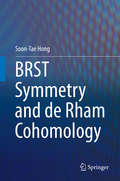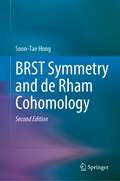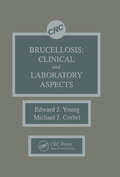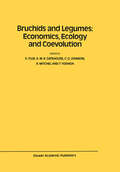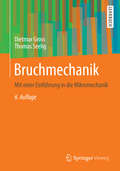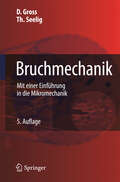- Table View
- List View
Brownian Motion and Molecular Reality (Oxford Studies in Philosophy of Science)
by George E. Smith Raghav SethBetween 1905 and 1913, French physicist Jean Perrin's experiments on Brownian motion ostensibly put a definitive end to the long debate regarding the real existence of molecules, proving the atomic theory of matter. While Perrin's results had a significant impact at the time, later examination of his experiments questioned whether he really gained experimental access to the molecular realm. The experiments were successful in determining the mean kinetic energy of the granules of Brownian motion; however, the values for molecular magnitudes Perrin inferred from them simply presupposed that the granule mean kinetic energy was the same as the mean molecular kinetic energy in the fluid in which the granules move. This stipulation became increasingly questionable in the years between 1908 and 1913, as significantly lower values for these magnitudes were obtained from other experimental results like alpha-particle emissions, ionization, and Planck's blackbody radiation equation. In this case study in the history and philosophy of science, George E. Smith and Raghav Seth here argue that despite doubts, Perrin's measurements were nevertheless exemplars of theory-mediated measurement-the practice of obtaining values for an inaccessible quantity by inferring them from an accessible proxy via theoretical relationships between them. They argue that it was actually Perrin more than any of his contemporaries who championed this approach during the years in question. The practice of theory-mediated measurement in physics had a long history before 1900, but the concerted efforts of Perrin, Rutherford, Millikan, Planck, and their colleagues led to the central role this form of evidence has had in microphysical research ever since. Seth and Smith's study thus replaces an untenable legend with an account that is not only tenable, but more instructive about what the evidence did and did not show.
Brownian Motion and Stochastic Calculus (Graduate Texts in Mathematics #113)
by Ioannis Karatzas Steven ShreveA graduate-course text, written for readers familiar with measure-theoretic probability and discrete-time processes, wishing to explore stochastic processes in continuous time. The vehicle chosen for this exposition is Brownian motion, which is presented as the canonical example of both a martingale and a Markov process with continuous paths. In this context, the theory of stochastic integration and stochastic calculus is developed, illustrated by results concerning representations of martingales and change of measure on Wiener space, which in turn permit a presentation of recent advances in financial economics. The book contains a detailed discussion of weak and strong solutions of stochastic differential equations and a study of local time for semimartingales, with special emphasis on the theory of Brownian local time. The whole is backed by a large number of problems and exercises.
Brownian Motion, Martingales, and Stochastic Calculus (Graduate Texts in Mathematics #274)
by Jean-François Le GallThis book offers a rigorous and self-contained presentation of stochastic integration and stochastic calculus within the general framework of continuous semimartingales. The main tools of stochastic calculus, including Itô’s formula, the optional stopping theorem and Girsanov’s theorem, are treated in detail alongside many illustrative examples. The book also contains an introduction to Markov processes, with applications to solutions of stochastic differential equations and to connections between Brownian motion and partial differential equations. The theory of local times of semimartingales is discussed in the last chapter.Since its invention by Itô, stochastic calculus has proven to be one of the most important techniques of modern probability theory, and has been used in the most recent theoretical advances as well as in applications to other fields such as mathematical finance. Brownian Motion, Martingales, and Stochastic Calculus provides a strong theoretical background to the reader interested in such developments.Beginning graduate or advanced undergraduate students will benefit from this detailed approach to an essential area of probability theory. The emphasis is on concise and efficient presentation, without any concession to mathematical rigor. The material has been taught by the author for several years in graduate courses at two of the most prestigious French universities. The fact that proofs are given with full details makes the book particularly suitable for self-study. The numerous exercises help the reader to get acquainted with the tools of stochastic calculus.
Brown's Introduction to Organic Chemistry, Global Edition
by William H. BrownBrown's INTRODUCTION TO ORGANIC CHEMISTRY This book is designed as an introductory course in organic chemistry for students who intend to pursue careers in sciences. The text highlights the interrelation between organic chemistry and other areas of science, particularly the biological and health sciences. It illustrates the use of organic chemistry as a tool in these sciences, stressing on the organic compounds, both natural and synthetic, that surround us in everyday life. The aim is to help students recognize that organic chemistry is a dynamic and ever-expanding area of science waiting openly for those who are prepared, both by training and an inquisitive nature, to ask questions and explore.
BRST Symmetry and de Rham Cohomology
by Soon-Tae HongThis book provides an advanced introduction to extended theories of quantum field theory and algebraic topology, including Hamiltonian quantization associated with some geometrical constraints, symplectic embedding and Hamilton-Jacobi quantization and Becci-Rouet-Stora-Tyutin (BRST) symmetry, as well as de Rham cohomology. It offers a critical overview of the research in this area and unifies the existing literature, employing a consistent notation.Although the results presented apply in principle to all alternative quantization schemes, special emphasis is placed on the BRST quantization for constrained physical systems and its corresponding de Rham cohomology group structure. These were studied by theoretical physicists from the early 1960s and appeared in attempts to quantize rigorously some physical theories such as solitons and other models subject to geometrical constraints. In particular, phenomenological soliton theories such as Skyrmion and chiral bag models have seen a revival following experimental data from the SAMPLE and HAPPEX Collaborations and these are discussed. The book describes how these model predictions were shown to include rigorous treatments of geometrical constraints because these constraints affect the predictions themselves. The application of the BRST symmetry to the de Rham cohomology contributes to a deep understanding of Hilbert space of constrained physical theories. Aimed at graduate-level students in quantum field theory, the book will also serve as a useful reference for those working in the field. An extensive bibliography guides the reader towards the source literature on particular topics.
BRST Symmetry and de Rham Cohomology
by Soon-Tae HongThis book provides an advanced introduction to extended theories of quantum field theory and algebraic topology, including Hamiltonian quantization associated with some geometrical constraints, symplectic embedding and Hamilton-Jacobi quantization and Becchi-Rouet-Stora-Tyutin (BRST) symmetry, as well as de Rham cohomology. This extended new edition offers a multifaced insight into phenomenology of particles such as baryons and photons, in terms of extended objects. In particular, in the second edition, the baryons are described in hypersphere soliton model, and the photon properties are additionally included in stringy photon model and in Dirac type relativistic quantum mechanics for a photon.It offers a critical overview of the research in this area and unifies the existing literatures, employing a consistent notation. Although the results presented apply in principle to all alternative quantization schemes, special emphasis is placed on the BRST quantization and its de Rham cohomology group which contribute to a deep understanding of constrained physical theories. The book describes how solitons and other models subject to constraints include rigorous treatments of the geometrical constraints which affect the predictions themselves. The book is intended for use by any graduate-level student with quantum field and relativity theories, and it also serves as a useful reference for those working in the field. An extensive bibliography guides the reader toward the source literature on particular topics.
Bruce Arrigo: Activism, Crime, and Justice (Palgrave Pioneers in Criminology)
by David PolizziThis book examines various aspects of the work of Bruce Arrigo related to therapeutic jurisprudence, criminal justice ethics, and the place of critical theory in criminology and related fields. Arrigo’s work spans over thirty years and during that time has been an important voice in the practical and theoretical application of post-modern and critical theoretical approaches to mental illness, the practice of forensic psychology, and a wide variety of critical reflection concerning incarceration, rehabilitation, and the ethical practice within the criminal justice system. Each individual contributor offers their own perspective on his work and its specific influence on the topic under discussion. This book speaks to academics focused on the application of critical criminological theory within a variety of disciplinary contexts. These include forensic psychology, psychological jurisprudence, criminal justice ethics, and philosophically based critiques of the law and mental health and criminal justice activism.
Bruce M. Russett: Pioneer in the Scientific and Normative Study of War, Peace, and Policy (SpringerBriefs on Pioneers in Science and Practice #34)
by Harvey StarrThis book provides a comprehensive treatment of Russett’s scientific contributions, with key examples of his major studies. It will greatly benefit today’s International Relations students, deepening their understanding of the field’s theory and methods.Bruce M. Russett was a founder of, and continues to be a pioneer in, the empirical analytical study of international relations and foreign policy. He has produced groundbreaking works on methodology, data collection and the application of economics to the field of international relations—especially in the area of analytical relationships between theory, policy and normative standards for morality and ethics. His body of work has clarified and furthered our understanding of peace studies by addressing power and conflict, cooperation, integration and community, democratic/Kantian peace, economic development, dependency and inequality, and the relationships between domestic and foreign politics. Russett’s academic achievements and standing are the result of his bringing these areas together as a coherent entity, based on his eclectic ability to “cross boundaries” with regard to academic disciplines, sub-disciplines, methods of data gathering and analysis, and broad theoretical perspectives, as well as basic and applied research.
Brucellosis: Clinical and Laboratory Aspects
by Edward J. Young Michael J. CorbelFourteen brucellosis experts from seven countries discuss the history, epidemiology, microbiology, immunology, diagnosis, treatment, and control of brucellosis in animals and man. Edited by members of the World Health Organization's Expert Committee on Brucellosis, this text is the first comprehensive treatment of the disease since The Nature of Brucellosis by Wesley W. Spink in 1956. Topics reviewed with current references include infection caused by newer species of Brucella, such as B. canis, newer diagnostic techniques, such as radioimmunoassay and ELISA, and newer treatments, such as rifampin and the quinolones. The pathogenesis and pathophysiology of brucellosis is reviewed in depth, correlating the disease in animals with the illness in humans. This volume is extremely useful for clinicians, researchers, and students in medicine, veterinary science, microbiology, immunology, epidemiology, public health, and international health.
Brucellosis: Clinical and Laboratory Aspects
by Edward J. Young Michael J. CorbelFourteen brucellosis experts from seven countries discuss the history, epidemiology, microbiology, immunology, diagnosis, treatment, and control of brucellosis in animals and man. Edited by members of the World Health Organization's Expert Committee on Brucellosis, this text is the first comprehensive treatment of the disease since The Nature of Brucellosis by Wesley W. Spink in 1956. Topics reviewed with current references include infection caused by newer species of Brucella, such as B. canis, newer diagnostic techniques, such as radioimmunoassay and ELISA, and newer treatments, such as rifampin and the quinolones. The pathogenesis and pathophysiology of brucellosis is reviewed in depth, correlating the disease in animals with the illness in humans. This volume is extremely useful for clinicians, researchers, and students in medicine, veterinary science, microbiology, immunology, epidemiology, public health, and international health.
Bruchids and Legumes: Proceedings of the Second International Symposium on Bruchids and Legumes (ISBL-2) held at Okayama (Japan), September 6–9, 1989 (Series Entomologica #46)
by K. Fujii A. M. R. Gatehouse C. D. Johnson R. Mitchel Teruhiko YoshidaIn 1980, the International Symposium on the Ecology of Bruchids Attacking Legumes (Pulses), organized by Dr. Labeyrie, was held at Tours, France. Since then, there has been tremendous progress in the area of Bruchid and Legume research. At the same time, as we face the problems of world-wide population explosion and food shortage, the importance of legumes as the world's major protein source is rapidly increasing, especial ly in tropical regions. Thus, it seemed appropriate to hold the Second Symposium in order to review the recent progress in the control of Bruchids and in the biology and ecology of Bruchids and legumes. This is an important part of the search for ways to integrate these fields with a common perspective. The Second International Symposium on Bruchids and Legumes (ISBL-II) was held in September 6-9, 1989 at Okayama, Japan under the joint auspices of the Japanese Society of Applied Entomology and Zoology and of the Foundation for Advancement of International Science. Significant contributions have originated in Japan on the study of Bruchid and legumes. Most notably, the study on population ecology by Professor S.
Bruchmechanik: Mit einer Einführung in die Mikromechanik
by Dietmar GrossGrundlegende Prinzipien und Arbeitsmethoden der Bruch- und Mikromechanik: Im Vordergrund steht die mechanische Beschreibung, wobei diese Einführung auch materialspezifische Aspekte diskutiert. Auf kontinuumsmechanische Grundlagen folgt ein Einblick in die klassischen Bruch- und Versagenshypothesen sowie in makro- und mikroskopische Phänomene des Bruchs. Ein umfangreicher Teil ist der linearen und elastisch-plastischen Bruchmechanik gewidmet.
Bruchmechanik: Mit einer Einführung in die Mikromechanik
by Dietmar Gross Thomas SeeligDas Lehrbuch führt in die grundlegenden Prinzipien und Arbeitsmethoden der Bruchmechanik und Mikromechanik ein. Im Vordergrund steht die mechanische Beschreibung von Bruchvorgängen, wobei auch materialspezifische Aspekte diskutiert werden. Auf die Behandlung von kontinuumsmechanischen und phänomenologischen Grundlagen folgt ein Einblick in die klassischen Bruch- und Versagenshypothesen sowie in makro- und mikroskopische Phänomene des Bruchs. Ein umfangreicher Teil ist der linearen und elastisch-plastischen Bruchmechanik gewidmet. Weitere Themen sind die Kriechbruchmechanik, Bruchdynamik, Schädigungsmechanik sowie die probabilistische Bruchmechanik. Eine Einführung in die Mikromechanik und die Homogenisierung elastischer, elastisch-plastischer und thermoelastischer Materialien ergänzt das Werk. Die 6. Auflage enthält zahlreiche Erweiterungen, unter anderem auch zu Aspekten der numerischen Behandlung bruchmechanischer Probleme.
Bruchmechanik: Mit einer Einführung in die Mikromechanik
by Dietmar Gross Thomas SeeligGrundlegende Prinzipien und Arbeitsmethoden der Bruch- und Mikromechanik: Im Vordergrund steht die mechanische Beschreibung, wobei diese Einführung auch materialspezifische Aspekte diskutiert. Auf kontinuumsmechanische Grundlagen folgt ein Einblick in die klassischen Bruch- und Versagenshypothesen sowie in makro- und mikroskopische Phänomene des Bruchs. Ein umfangreicher Teil ist der linearen und elastisch-plastischen Bruchmechanik gewidmet.
Bruchmechanische Bewertung von Oberflächenrissen: Grundlagen, Experimente, Anwendungen (WFT Werkstoff-Forschung und -Technik #1)
by E. SommerBruchwiderstand und Bemessung von Stahlbeton- und Spannbetontragwerken: Erläuterungen zu Richtlinie 34 der Norm SIA 162 (Institut für Baustatik und Konstruktion #66)
by J. Grob ThürlimannBruchwiderstand von Kastenträgern aus Stahlbeton unter Torsion, Biegung und Querkraft (Institut für Baustatik und Konstruktion #69)
by P. LüchingerBruchwiderstand von Stahlbetonbalken unter Torsion und Biegung (Institut für Baustatik und Konstruktion #26)
by B. LampertBrückenkurs Physik: MINTestanforderungen fürs Studium
by Dominik Giel Ulrich HartenDieses Lehrbuch fasst alle wesentlichen, für das Studium eines MINT-Faches relevanten Inhalte der Physik zusammen und hilft physikalisches Grundwissen aufzufrischen. Es unterstützt Studienanfänger dabei, die Routine in der konkreten Anwendung, die an der Hochschule vorausgesetzt wird, zu festigen. Dabei folgt die Stoffauswahl dem Mindestanforderungskatalog Physik, den ein Arbeitskreis aus Professoren der baden-württembergischen Hochschulen für angewandte Wissenschaften zusammengestellt hat. Die Grundbegriffe aus Mechanik, Elektrizität, Wärmelehre und Optik werden verständlich dargestellt und durch zahlreiche Abbildungen veranschaulicht. Durch mehr als 111 Übungsaufgaben mit Lösungen kann der Leser seine Fähigkeiten selbständig überprüfen, erweitern und trainieren. So bietet dieses Werk als Brückenkurs eine optimale Vorbereitung für die Vorlesungen zur Physik – und leistet auch darüber hinaus in ersten zwei Semestern zur Vorbereitung von Übungszetteln und den ersten Klausuren wertvolle Dienste.
Bruno Latour (Key Contemporary Thinkers)
by Gerard de VriesBruno Latour is among the most important figures in contemporary philosophy and social science. His ethnographic studies have revolutionized our understanding of areas as diverse as science, law, politics and religion. To facilitate a more realistic understanding of the world, Latour has introduced a radically fresh philosophical terminology and a new approach to social science, ‘Actor-Network Theory’. In seminal works such as Laboratory Life, We Have Never Been Modern and An Inquiry into Modes of Existence, Latour has outlined an alternative to the foundational categories of ‘modern’ western thought Ð particularly its distinction between society and nature Ð that has major consequences for our understanding of the ecological crisis and of the role of science in democratic societies. Latour’s ‘empirical philosophy’ has evolved considerably over the past four decades. In this lucid and compelling book, Gerard de Vries provides one of the first overviews of Latour’s work. He guides readers through Latour’s main publications, from his early ethnographies to his more recent philosophical works, showing with considerable skill how Latour’s ideas have developed. This book will be of great value to students and scholars attempting to come to terms with the immense challenge posed by Latour’s thought. It will be of interest to those studying philosophy, anthropology, sociology, science and technology studies, and almost all other branches of the social sciences and humanities.
Bruno Latour (Key Contemporary Thinkers)
by Gerard de VriesBruno Latour is among the most important figures in contemporary philosophy and social science. His ethnographic studies have revolutionized our understanding of areas as diverse as science, law, politics and religion. To facilitate a more realistic understanding of the world, Latour has introduced a radically fresh philosophical terminology and a new approach to social science, ‘Actor-Network Theory’. In seminal works such as Laboratory Life, We Have Never Been Modern and An Inquiry into Modes of Existence, Latour has outlined an alternative to the foundational categories of ‘modern’ western thought Ð particularly its distinction between society and nature Ð that has major consequences for our understanding of the ecological crisis and of the role of science in democratic societies. Latour’s ‘empirical philosophy’ has evolved considerably over the past four decades. In this lucid and compelling book, Gerard de Vries provides one of the first overviews of Latour’s work. He guides readers through Latour’s main publications, from his early ethnographies to his more recent philosophical works, showing with considerable skill how Latour’s ideas have developed. This book will be of great value to students and scholars attempting to come to terms with the immense challenge posed by Latour’s thought. It will be of interest to those studying philosophy, anthropology, sociology, science and technology studies, and almost all other branches of the social sciences and humanities.




